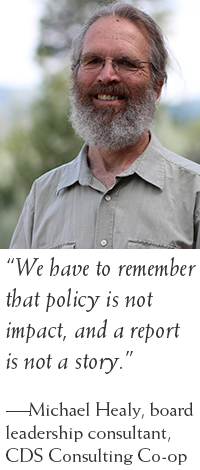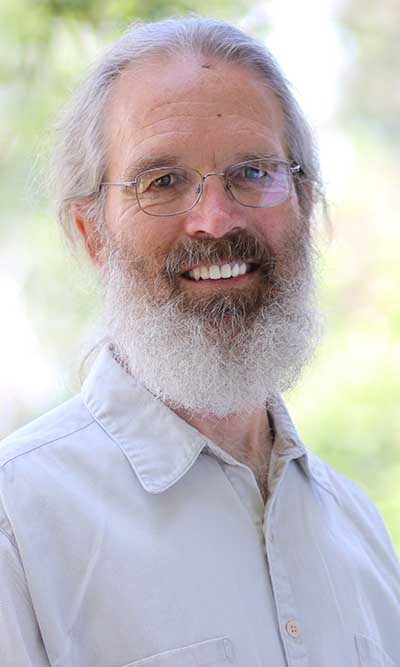An individual member-owner or customer or vendor could probably describe how the co-op impacts their life: This is where I get the food that feeds my family. Or, I see all my friends here. Or, this is the center of my community. Or, I make my living by selling my products here.
But how can the co-op describe the collective impact it has on that entire community of members, customers, producers and others? To tell that story, the co-op’s leaders have to do just a few things. Doing these things well makes it more likely that the story is a real page-turner: compelling, engaging, inviting. What are those few things?
First, the board articulates the impact that the co-op should strive toward. What results are we trying to achieve? Who should benefit from the co-op’s work? After answering these questions as clearly as possible, the board then empowers management to carry out the work needed to achieve these results.
 An empowered management will embed the Ends in the operational work, defining achievement with specific metrics and goals that will best show progress toward the Ends, and then crafting operational plans that move the co-op in the direction of those goals. Finally, management needs to compile data in a clear and straightforward report.
An empowered management will embed the Ends in the operational work, defining achievement with specific metrics and goals that will best show progress toward the Ends, and then crafting operational plans that move the co-op in the direction of those goals. Finally, management needs to compile data in a clear and straightforward report.
So there they are, the few things that form the core of the work of defining and describing the co-op’s impact. But we have to remember that policy is not impact, and a report is not a story. Much like learning to ride a bicycle, a novice focuses attention on the pedals or the handlebars; once you’ve got the hang of it, focus turns away from the mechanics and toward the thrill of traveling somewhere. Now you can begin to really imagine where you want to go.
The same process works for boards and Ends policies. When boards can move away from focusing on the policy itself, and when general managers can move away from focusing specifically on the monitoring report, together they can build an awareness and understanding of actual impact.
How do boards do their part? They begin with intention to look up and outward—away from the policy and the words, away from a frequent cycle of rewriting and revising. They expect and receive ends monitoring reports chock full of relevant data, helping them understand what the co-op is actually accomplishing. They expect and receive excellent operational plans that clearly connect to the ends policies and focus on achieving particular goals. Then the intention to look up and outward leads to how the board engages with the co-op’s member owners.
Boards can use the information they learn from the ends and planning reports in their communications with members. Newsletter articles or blog posts can regularly reference co-op impact and achievement, both what has happened up till now and what might happen if the co-op’s plans come to fruition. A recent article from the board of Brattleboro Food Co-op highlighted the co-op’s efforts to become “a regenerative business that has a net positive environmental impact.” Along with presenting specific data about the decrease in the amount of garbage the co-op sent to the landfill last year, the article invited members to think about how they could support the co-op’s efforts.
Boards can invite members into more personal conversations, either in the form of focus groups or within the context of the annual meeting or in myriad other ways. At Onion River Co-op’s annual meeting, members got to learn that 39% of their co-op’s sales were of local products, a 10% increase over the previous year. This information, taken straight out of the Ends report, was cause for celebration.
All of these conversations help create and maintain the sort of organizational alignment that Brett Fairbairn describes in his “Imagination Matters” video presentation in the Columinate Library. And when boards invite other community leaders into the conversation, they help build a community-wide understanding of the community’s needs and the co-op’s role in meeting at least some of those needs.
In a similar way, a general manager may focus on the mechanics of writing an Ends report. What data do I collect? How do I collect it? How do I put it into a report the board will accept? But even as a general manager works to master the mechanics of reporting, other powerful work can begin. By bringing the full management team and all employees into this work, the general manager begins to ensure that the cooperative organization is pointed in the right direction. Any and all employees can contribute to the definition of metrics, and to the plans which lead to accomplishment and cooperative impact.
Mike Anzalone, the general manager at Ozark Natural Foods in Arkansas, recently decided to breathe new life into the co-op’s Ends. Taking inspiration from the “Ends to Ends Strategic Process” presentation in the Columinate Library, Anzalone involved managers and staff in defining key parts of the Ends. When Mike presented this initial work to the board, he says, “The response has been great. It has created excellent dialogue in the meetings.” Anzalone summarizes the strong sense of alignment at ONF by adding, “The staff is involved, the managers, the general manager and the board are all taking an active role—Ends for Everyone.”
At co-ops that are having an impact, some general managers have found ways to ensure that employees are part of the planning, implementation and measuring of Ends accomplishment. The annual planning or business planning process includes a focus on the Ends, ensuring that everyone understands them and can understand how their efforts contribute to the co-op’s goals. And for co-ops using Open Book Management, Ends metrics become integrated into the performance goals that employees focus on regularly.
So what is the story of co-op impact as told in annual reports? In Buffalo, NY, Lexington Co-operative Market can tell the story of contributing over $7 million to their local economy. In their 2016 Annual report, the Menomonie Market Food Co-op tells the story of increasing sales of local products and their donations to local community groups while at the same time decreasing their greenhouse gas emissions per square foot of retail space. Onion River Co-op (aka City Market) can tell the story of what can happen when you grow from a medium sized co-op to a large co-op: among other things this co-op’s customers purchased over $16 million of local products in 2016.
Remember the International Year of the Cooperative way back in 2012? The International Cooperative Alliance’s theme for that global celebration was “Cooperative Enterprises Build a Better World.” Powerful Ends policies and focused Ends reports don’t actually help us do that work of building, but they can help us define and describe the work.
Using that Ends information as a core of the co-op’s communications can help the people who are actually doing the work of building a better world—the farmers and producers who bring us the food, the members and other customers who purchase those products, and the employees who ensure that the co-op successfully connects those consumers and producers—understand how their individual actions and decisions contribute to a collective impact.
Have more questions?
Get in touch with one of our consultants.

